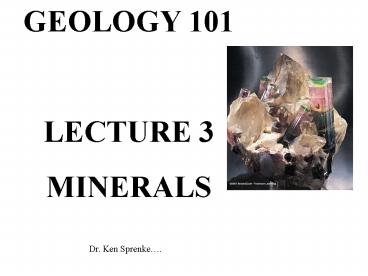GEOLOGY 101 - PowerPoint PPT Presentation
1 / 64
Title:
GEOLOGY 101
Description:
Mineral properties: hardness. density. color. lustre. crystal form ... It has a distinctive taste. Halite. A rock is defined as an aggregate of minerals. ... – PowerPoint PPT presentation
Number of Views:186
Avg rating:3.0/5.0
Title: GEOLOGY 101
1
GEOLOGY 101 LECTURE 3 MINERALS
Dr. Ken Sprenke.
2
Diamond A precious mineral. The hardest
mineral Transparent carbon..
3
Turquoise A semiprecous mineral. The blue
color comes from copper...
4
Amber is fossil tree sap. Technically it is not
a mineral because it is organic..
5
A mineral must be 1. Naturally occurring 2.
Inorganic 3. Crystalline
Galenalead ore...
6
Here is water in three different states. Which
ia a mineral?
Ice is a mineral. It occurs naturally, is
inorganic, and is crystalline...
7
The atom..
8
Atomic number number of protons Element names
depends on number of protons
Atomic mass number protons neutrons Isotope
name depends on number of neutrons.
9
In ionic bonding, a single electron in an outer
shell is sent over to fill an electron hole in
the outer shell of a neighbor.
What mineral has this composition? HALITE!..
10
Ionic bonding produces positive and negative
charges that attract each other. A cubic
crystalline structure is formed in halite..
11
Call the FBI, here are some real
radicals! Radicals are groups of elements held
together by ionic bonding..
12
In pop culture there are Barry Bonds, and Bobby
Bonds, and Gary (US) Bonds but in geology there
are only Ionic bonds (such as in halite and
silicate) Covalent bonds (electrons are shared
such as in diamond and graphite). Metallic bonds
(electrons are shared and free to move) such as
in gold, silver, copper) van der Waals bonds
(weak attraction between sheets)..
COVALENT BONDING OF CARBON
Van der Waals bonding of mica sheets..
13
Crystalline shapes regular arrangement of atoms
Cubic in halite, pyrite, galena
Dodecahedron (garnet)
Prism (quartz).
Octahedron (diamond)
14
You may think the wine glasses that your
mother-in-law gave you are genuine crystal,
but ..materials (eg glass) that do not have a
regular arrangement of atoms are called
amorphuous. Many crystalline substances will
break along flat cleavage planes. Glass is not
crystalline. It always breaks irregularly...
15
Most minerals are chemical compunds but some are
native elements (gold, silver, platinum,
copper)...
16
Si.
Oxygen
Most minerals are silicates. They use the radical
SiO4. The silica tetrahedron is the building
block of the silicates.
17
In some minerals such as olivine and garnet, the
tetrahedra do not connect directly with each
other.
.
18
In the chain silicates, one or two oxygens are
shared between tetrahedrons..
19
The sheet silicates share three oxygens with
their neighbors....
Biotite mica
20
In framework silicates, all four oxygens are
shared with neighboring tetrahedrons...
Quartz amethyst
21
Next Class Mineral Classes Read Chapter 2
22
WelcomeGeology 101Lecture 4 Mineral Classes
- Ken Sprenke, Ph.D....
23
Ferromagnesian silicates has much iron and
magnesium. They are usually dark green. Examples
are olivine, hornblende, pyroxene, biotite...
24
Nonferromagnesian silicates lack iron and
magnesium and are light in color and are low
density (quartz, orthoclase feldspar, plagioclase
feldspar, muscovite mica)..
25
Other mineral groups include carbonates (eg
calcite) sulfides (eg galena) sulphates (eg
gypsum) halides (eg halite)...
26
Mineral properties hardness density color lus
tre crystal form cleavage fracture streak..
27
Mohs Hardness Scale Scales hardness from 1
(Talc) to 10 (Diamond) Politically incorrect
acrynym from my school days Tall Girls Can Flirt
And Other Queer Things Can Do. Talc, Gypsum,
Calcite, Fluorite, Apatite, Orthoclase, Quartz,
Topaz,Corundum, Diamond
Vertically-challenged persons can carry on fluent
intelligent conversations and other non-sequeous
things can do without regard to sexual
orientation...
28
Hematite has metallic lustre orthoclase has
nonmetallic lustre...
29
Fluorite has distinctive cubic crystals...
30
Clacite has distinctive crystal forms and
rhombohedral cleavage..
31
This barite desert rose has a distinctive crystal
form...
32
Varieties of quartz are recognized by distinctive
colors This is citrine quartz...
33
This is milky or bull quartz..
34
This quartz agate is cryptocrystalline (tiny
crystals)..
35
Rosey Quartz..
36
Smokey Quartz..
37
Amethyst Quartz..
38
..
39
..
40
..
41
..
42
Photomicrographs of rocks show cleavage in the
mineral grains...
43
This mineral cleaves into perfect cubes and
octahdrons. fluorite
44
Magnetite is magnetic..
45
Graphite is so soft it writes on paper..
46
Calcite crystals show double refraction...
47
Note the quartz prisms and the purple color
Amethyst.
48
This mineral has hardness 5. Note the apple green
color. Apatite.
49
Note the octahedral form. This has hardness
10. Diamond.
50
This mineral has hardness 9 and is emerald
greem. Emerald corundum.
51
These little prisms of milky white color can be
scratched by a knife and bubble under
acid. Calcite
52
This native element weathers to green. Native
copper.
53
This is the January birthstone. Note the
dodecahedral form. Garnet
54
This precious gem has a star (like garnet) when
polished. Sapphire corundum.
55
This mineral is very soft and very yellow and
very odiferous.. Native sulphur.
56
This is the most common mineral. It can just
barely be scratched with a knife. Crystals are
distinctive. Plagioclase feldspar.
57
This mineral has a gray metallic lustre but is
not a metal. It is very soft. Graphite
58
This mineral has hardness 1. Babies like it a
lot. Talc
59
This mineral is common in the mantle. Its color
is diagnostic. Olivine
60
This precious gem is famous. Wars are fought for
gems like this. Hope Diamond
61
At the other extreme, this mineral is worth maybe
0.00000001 cents per carat but wars have been
fought over it as well and civilizations have
come and gone based on its availablity. It has a
distinctive taste. Halite
62
A rock is defined as an aggregate of minerals.
The common minerals that form rocks are called
rock-forming minerals...
63
This microscopic view shows the minerals grains
in granite..
64
Next Class Read Chapter 3 IGNEOUS ROCKS.

